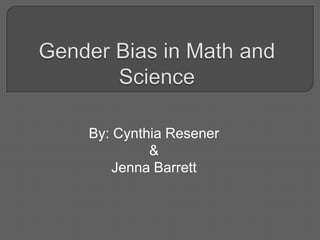
Gender Bias In Math And Science
- 1. Gender Bias in Math and Science By: Cynthia Resener & Jenna Barrett
- 2. Historical Background Who: The media is responsible for much of the gender bias that we observe today. Male commercials are fast-paced and picture aggression Female commercials are slower paced and picture females as sensing and submissive Because the technology and math areas are so male dominated these stereotypes infiltrate the mainstream philosophy of most professional offices and organizations making it difficult for women to feel comfortable and valued.
- 3. Historical Background cont. When: Has been around since the beginning of teaching, but came to everyone’s attention in the early 90s Why: Girls are not encouraged to achieve in these areas and are not given the same opportunities to learn as the male students.
- 4. Main Reasons “Parental and societal perceptions and teacher behavior and expectations” are the main reasons that girls turn away from science and thus don’t compete for the technical jobs. This is why we are passing on biases onto our children thus perpetuating our biases to the next generation.
- 5. Main Reasons cont. Teachers and parents pass on their likes and dislikes in very subtle ways. A teacher who may have disliked math or science in their own schooling is responsible for teaching these subjects to K-5th graders, and will also pass on their dislike for these subjects.
- 6. Main Reasons cont. Girls from birth are encouraged to be less independent and adventuresome and to be more passive than their male counterparts. It should come as no surprise that boys then take the lead in science lab actually using the equipment while the girls only write up the experiments. The girls then become watchers and not participants in science. It’s difficult to just watch and become competent with the hardware.
- 7. Main Reasons cont. “Because of their socialization and lack of experience in manipulating objects, many girls do not fell comfortable in the science classroom, thereby inhibiting, physiologically, their ability to excel.” Technology classes have experienced very similar findings as the class involves using equipment that may seem unfamiliar and different to the girls.
- 8. Some Explanations An explanation of why girls might have more problems than boys in using programs is presented by Mangione’s study(1995) that reviewed previous studies on educational software from 1983-1993. Software was found to be gender specific- male software was “game oriented and action oriented,” while female software was “tool-oriented.”
- 9. Explanations cont. Girls enjoy “maintaining harmonious relationships” in their computer activities while boys preferred to argue about the rules and continuing to quarrel while they played the games. Girls would stop the game if too much controversy was involved and switch to a more non-confrontational activity.
- 10. Explanations cont. More importantly Mangione’s study found that non-gender specific software looked more like the software created for males. It was suggested that using software designed for the other sex could result in “anxiety producing” scenarios. That is, because the software created for males and females seemed more male oriented, girls would not feel as comfortable using the “male” software.
- 11. Explanations cont. The reason more girls don’t take programming courses is that the approach and computer itself is male oriented. Mangione cites Turkle’s work in 1984 that examined male/female ways of programming.
- 12. Explanations cont. Boys are rewarded by using the technique that is both more natural to them – top-down design and considered the “right” approach, while girls prefer to program in what Turkle calls a “soft mastery” approach. While both approaches get the job done, the top-down approach is the accepted paradigm in the male dominated computer science area(Valentine, 1998).
- 13. Current Status & Present Issues In 1992 data was collected from ten different countries In 1994 the data from 1992 was used and reported that “sex of the student is the only factor with a substantial influence on student achievement in all countries.” Consistently across all countries, female students reported “having more difficulty in understanding or using programs” and enjoyed using the computer less than males.
- 16. Jenna’s Reflection I have always known there was a bias between genders I haven’t really had any experience with this topic. Though I am sure I have , I just never let it effect me
- 17. Jenna’s reflection cont. That there has always been a bias against women. Though I’ve always been aware of it, I feel like they should try to find ways to make this bias less known I don’t believe that it will really effect students. It will always be there, whether or not it is prevalent or not
- 18. Reflections cont. Just remember that many of your female students will have the mind set that they can’t have a career in math, science, or technology, but tell them that they can do what ever they put their mind to, and if they want a career in math, science, or technology then they can as long as they work hard to get there.
- 19. References Boland, Pat, Ed. (1995). Gender-Fair Math. Equity in Education Series. Retrieved April 6, 2009, from http://www.eric.ed.gov/ERICDocs/data/ericdocs2sql/content_storage_01/0000019b/80/14/fc/b5.pdf Valentine, Elizabeth F. (1998). Gender Differences in Learning and Achievement in Mathematics, Science, and Technology and Strategies for Equity. Retrieved April 6, 2009, from http://www.eric.ed.gov/ERICDocs/data/ericdocs2sql/content_storage_01/0000019b/80/16/9d/35.pdf